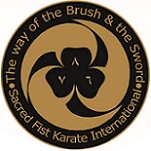|
Nanbu had developed sankukai a similar form of karate but later withdrew
from both his system and he entire world of martial arts, having become
disillusioned with the competition and politics involved. After moving to
France his passion for the arts of his native country was rekindled and in
1978 he developed the new system of Nanbudo. It is considered to be a
holisitc method of self defence and although many of the techniques are
based on his early karate career, he also incorporated elements of his own
philosophy.
Physical and mental health
The art is divided into 4
major aspects 'kata','randori','ju' and 'ki'.
Kata incorporates 3 levels basic, advanced and
superior.Most techniques are performed unarmed the system includes training
with a six-foot bo staff and a bokken.There are also a number of hidden
methods that students are encouragedto discover and develop themselves.
Randori is a formalized set of techniques in
which attacker and defender engage in a set of prearranged movements,such as
punch and kicks, in order to develop good timing and discipline, and correct
distancing.
Ju is a prefix added to other elements of the
art, most commonly 'jurandori' and indicates a competitive element.
Ki is described as a way of holistically
developing the body and physique allowing ki to flow freely through the
body. |













